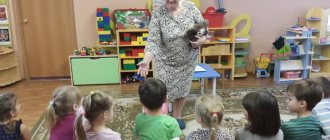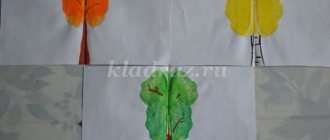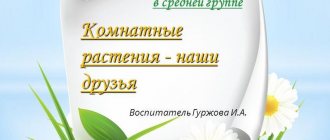MAGAZINE Preschooler.RF
Summary of direct educational activities for children of the middle group “Vegetables in a jar”in the educational field “Artistic and aesthetic development” (module “Implementation of independent creative activity of children in visual arts” )
Authors:
- Plotnikova Antonina Sergeevna - teacher
- Pavlova Elena Leonidovna - head
MBDOU "Kindergarten No. 3" Cheboksary
Goal: To consolidate children's knowledge about vegetables and their preparation for the winter.
Tasks:
- Educational: summarize children’s ideas about the shape, color, size of vegetables. Learn to distinguish and name vegetables. Introduce an unconventional drawing technique: stamping with a sponge through a stencil.
- Developmental: develop sensory sensations, imagination.
- Educational: to cultivate accuracy in working with paints, to make children want to help the heroes in a difficult situation. Continue to develop the ability to perform certain actions according to the verbal instructions of the teacher.
Demonstration material: letter, 2-3 baskets of dummies of tomatoes and cucumbers, grandmother’s house, easel.
Handouts: landscape paper cut in the shape of a jar, stencils of cucumbers, tomatoes, foam rubber stamps, gouache paints in red and green colors, colored crayons, felt-tip pen, rag napkins, wet wipes, house, gouache plates, envelope, tape recorder.
Vocabulary work: preserve, prepare.
Individual work: providing assistance to children as needed.
Preliminary work: conversation about vegetables grown in the garden, harvesting in the autumn.
Reading literary fairy talesK. Chukovsky’s “Fedorino’s Mountain”, V. Suteev’s “Sack of Apples”, Y. Tuvim’s poem “Vegetables”.
Examination of pictures, posters, plot pictures on the topic “Vegetables”.
D/i “The fourth odd one”, “Tops and roots”, “What grows where” .
Methodical techniques:
- Greetings.
- Surprise moment “Letter from Grandma Fedora” .
- Game motivation “We’re going to the village to help grandma .
- Demonstration and explanation by the teacher of non-traditional sponge painting.
- Finger gymnastics “Cabbage” .
- Children doing their own work.
- Individual assistance to those in need.
- Children's analysis of their work.
- Analysis of children's activities.
The progress of educational activities directly.
Introductory part.
Educator: -Today is a good day,
Let's smile at each other.
And with such a good mood
Let's say hello to our guests.
Let's say "Good morning!" or “Hello!”
Children: - Hello!
Educator: -Guys, today the postman brought an interesting letter to our group. (shows to children). Who do you think it could be from? (from grandmother Fedora). How did you guess? What told you? (on the envelope there are scenes from K. Chukovsky’s fairy tale “Fedorino’s Grief” ). Would you like to hear what our friend Grandma Fedora wrote to us?
“Hello, my dear guys! Summer has flown by and autumn has arrived. And I immediately had a lot to do in the garden: before the onset of cold weather, I harvested the entire harvest. I need to preserve them in jars. I can't handle it alone. Come and help me please. I'll be looking forward to seeing you all! With love, your grandmother Fedora."
Vocabulary work: preserve.
Teacher - Guys, how do you understand the word “preserve” ? (children's answers: close for the winter in jars for long-term storage). Dasha, (names of 2-3 children) repeat the word “preserve” . Sasha, what can you preserve? Lera, what can you use to preserve vegetables? Safina, why do people can can vegetables?
Game motivation.
Educator: - Guys, can we help Grandma Fedora? We go to the village to visit our grandmother. But the road is long, we cannot do without magic here. To do this, I suggest closing your eyes, spinning around and saying the magic words “Spin, spin, find yourself visiting grandma . (fairytale music sounds). Open your eyes. So we were transported to Grandma Fedora’s yard. (The house, and in front of it there are baskets of tomatoes and cucumbers).
Guys, look how big and beautiful the grandmother’s garden is. What vegetables do you see here? What shape, color, size, taste are they? But my grandmother is not at home, she probably went for help. We need to help Grandma Fedora preserve the harvest. Guys, Fedora’s grandmother offers to preserve all these vegetables in jars. Has anyone seen your parents do this? (children's answers).
Main part.
Educator: - Let's help Grandma Fedora. Now I will show you how this can be done (showing and explaining the teacher).
Come in, sit down on the carpet.
I take a jar, put a tomato stencil on the jar, hold it with my left hand, and take a sponge in my right hand, dip it in red paint, and begin using the dipping method to carefully paint the vegetable - the tomato. I fill the entire jar with tomatoes, and then close the jar with a lid, drawing a line on top with a brush, and my workpiece is ready.
Before you start working, I suggest you stretch your fingers.
Finger gymnastics “Cabbage” .
We chop and chop the cabbage (Make sharp movements with straight hands up and down.)
We are three carrots, three (Clench your fingers into fists, move your fists towards you and away from you.)
We salt the cabbage, salt it (Make movements with your fingers, sprinkle salt from a pinch.)
We squeeze the cabbage, squeeze it (Intensely clench your fingers into a fist.)
Now I suggest you go and sit at the tables to make your preparations.
Educator: – You have everything you need for work on your tables. Jar templates, cucumber and tomato stencils, red and green paints, napkins.
We place the stencils on the free space in the jar and continue to paint the vegetables as desired.
(At the end, as they finish their work, the children analyze their work and hang it on a magnetic board).
Final part.
Educator: - What great fellows you all are! What did you do today? What did you like most? What vegetables are in their jars? How did we help grandma? We need to tidy up our workspaces, clean our hands with napkins.
(Children's answers).
Educator: - Grandma Fedora will come, see the preparations and be very happy. It's time for us to go back to kindergarten. We close our eyes to the magic words “Turn around, turn around, you’ll find yourself in kindergarten!” We return to kindergarten.
Literature:
- “From birth to school” Approximate basic general education program for preschool education / ed. NOT. Veraksy, T.S. Komarova, M.A. Vasilyeva. – M.: “MOSAIC – SYNTHESIS” , 2014.
- Komarova T.S. Visual activities in kindergarten. - M.: Pedagogy, 1990.
- Lykova I.A. “Art activities in kindergarten. Middle group" . - M.: “Karapuz” , 2009.
- Drawing with preschool children: non-traditional techniques, planning, lesson notes. / Ed. Kazakova R.G. – M.: Sphere , 2005.
- Nikitina A.V. “Non-traditional drawing techniques in preschool educational institutions. A manual for educators and parents . – St. Petersburg: KARO, 2007.
Application
| Next > |
Abstract of the OOD on cognitive development “Vegetables in the garden” in the middle group
Olga Bogatova
Abstract of the OOD on cognitive development “Vegetables in the garden” in the middle group
Goal: to continue to enrich and improve children's understanding of vegetables .
— consolidate knowledge about vegetables (name, appearance)
;
- learn to distinguish vegetables by taste and touch;
- learn to write a story - description;
— clarify the idea of the health benefits of vegetables .
Materials and equipment: pictures with vegetables (tomato, cucumber, onion, carrot, cabbage, peas, pumpkin)
;
natural vegetables ; outline of the story - descriptions; "
Vegetables " coloring pages according to the number of children; colored pencils according to the number of children.
- Guys, I have a magic bag. Let's find out what's in it? (Yes)
Game "Find out by touch"
(The teacher puts natural vegetables )
— What is on the tray? Name it in one word. ( Vegetables .)
-Where do vegetables ? (In the garden , in the garden.)
— What is the name of the profession of a person who grows vegetables ? ( Vegetable grower .)
— How are vegetables ? (They cook soup, borscht, cabbage soup; fry, make puree, juice; salt; make filling for pies; eat raw; prepare salad.)
— What must you do with vegetables before using them? (Wash.)
Game "Taste"
(There are slices of vegetables . Each child takes a slice, tastes it and pronounces the name of the vegetable .)
Physical school
.
(Children imitate actions according to the teacher’s verbal instructions)
“We pull out the carrots. We pick cucumbers and tomatoes. We dig up the onion. We cut the cabbage." The game is repeated 2-3 times.
N/a: one cucumber, three cucumbers, five cucumbers, etc.
Drawing up a descriptive story according to plan
Children write a story describing a vegetable : “This is a cucumber. Grows in the garden , in the garden. Cucumber is green. The cucumber has an oval shape. They make salad and juice from cucumbers.”
Game "Guess what's in your hand?"
- Green, round, big, tasty, crispy. (Cabbage.)
— Red, triangular, small, sweet, juicy, crispy. (Carrot.)
- Yellow, round, large, bitter, crispy, (Onion)
— Green, oval, large or small, juicy, crispy. (Cucumber.)
- Red, round, big, juicy, tasty. (Tomato.)
The golden head is large and heavy.
The golden head lay down to rest.
Dried out in the hot sun
And bursts from the pods. (Peas)
(Children guess the riddle, the teacher shows them a natural vegetable .)
all vegetables be eaten raw? (Children's answers)
(the teacher talks about the benefits of vegetables for human health)
— In order to be healthy, you need to do gymnastics, walk a lot and don’t forget to eat vegetables . No other food is more beneficial. This is a real gift from nature.
(Children are invited to color a vegetable of their choice )
"Visiting Grandfather Folklore." Abstract of OOD on cognitive development and speech development in the middle group Integration: communication, physical development, environmental education, musical development, artistic and aesthetic development Types.
Abstract of the OOD on cognitive development “Vegetables, berries and fruits - vitamin products” Goal: to consolidate children’s ideas about the benefits of fruits, berries and vegetables as the main natural sources of vitamins and minerals.
Summary of OOD on cognitive development with elements of experimentation in the middle group “Hello, Droplet!” Goal: To help children understand what water is and why it is needed; introduce the properties of water: transparent, flowing, tasteless, odorless.
Summary of OOD on cognitive development in the middle group with elements of physical exercises “To the aid of Vitaminka!” Types of children's activities: cognitive-research, gaming, communication, physical education. Educational area: “Cognitive.
Abstract of educational activities on cognitive development in the middle group "House of Friendship" Abstract of educational activities on cognitive development in the middle group. Theme “House of Friendship” Goal: To form friendly relationships between preschoolers.
Abstract of educational activities on cognitive development in the middle group “Such an amazing animal - a porcupine” Design component Implementation of the content of the program in educational areas: “Cognitive development”, “Social-communicative.
Abstract of educational activities on cognitive development of FEMP in the middle group “Acquaintance with the number 4” Synopsis of organized educational activities on cognitive development (FEMP) in the middle group. Prepared and conducted by the teacher.
Summary of a lesson on the application “Vegetables in the garden” in the middle group Summary of a lesson on the application in the middle group on the topic “Vegetables in the garden” Objectives: Educational objectives: Teach children in unconventional ways.
Source
Lesson notes for the middle group “Vegetable garden”
Natalia Konovalova
Lesson notes for the middle group “Vegetable garden”
Goal: to consolidate children's knowledge about vegetables and fruits.
- distinguish, name and classify objects on the topic “vegetables and fruits”;
- describe the appearance of vegetables and fruits, draw simple conclusions about the growth of vegetables and fruits;
-continue to develop logical thinking;
-to form an interest in works of Russian folklore (riddles, proverbs, sayings)
;
-develop the ability to listen to each other without interrupting;
- cultivate a caring attitude towards nature.
-observation of the growth of vegetables in the kindergarten garden, assistance in harvesting;
-reading poems and stories about fruits and vegetables: “Grandma Thekla planted onions and beets in the garden”
;
RNS "The Man and the Bear"
;
Julian Tuwim "Vegetables"
;
-conversations about the benefits of vegetables and fruits;
- didactic games “Describe, we’ll guess”, “What’s extra?”, “Wonderful bag”, “In the garden, in the vegetable garden”;
- role-playing games “Vegetable shop”, “Cooking dinner”;
— listened to music: Russian folk melodies “In Autumn”
, songs
“Buy onions”
,
“Grapes, my grapes”
- Moldavian song, Russian.
text by D. Elchenko; listening to the Udmurt song “Collective Farm Garden” (Russian text by Bolotin)
;
- outdoor games “There is a scarecrow in the garden, the scarecrow is standing”, “A woman was sowing peas”, “Vegetable garden”, “Apple tree”.
Methodological techniques: game, visual, verbal, surprise moment.







